Abstract
We recently described a family where a deletion of the dystrophin gene was associated with a severe dilated cardiomyopathy without skeletal muscle weakness. The deletion removed the muscle promoter region and the first muscle exon, but not the brain or Purkinje-cell promoters. Dystrophin was detected immunocytochemically in the skeletal muscle from this family, despite the fact that the deletion eliminated the transcriptional start site of the muscle isoform. In order to determine which promoter was driving dystrophin transcription in skeletal muscle of these individuals, we first evaluated the expression of the exon 1 of muscle, brain, and Purkinje-cell isoforms in normal human skeletal and cardiac muscles and in mouse brain and cerebellum. Our data indicate that, with the exception of minimal expression of the brain isoform, only the muscle isoform is significantly transcribed in skeletal muscle, whereas both the exon 1 muscle and brain isoforms are highly expressed in cardiac muscle. In contrast to what is observed in normal muscle, the skeletal muscle of our patients showed expression of both the brain and the Purkinje-cell isoforms. The overexpression, in skeletal muscle, of these two isoforms thus appears to be of crucial importance in preventing a myopathy in these affected males. The reason for the severe cardiomyopathy remains speculative, in the absence of dystrophin data on their heart. However, we have found in the 5' end of intron 1, a region deleted in our cases, regulatory sequences that might be of importance for dystrophin expression in various tissues.(ABSTRACT TRUNCATED AT 250 WORDS)
Full text
PDF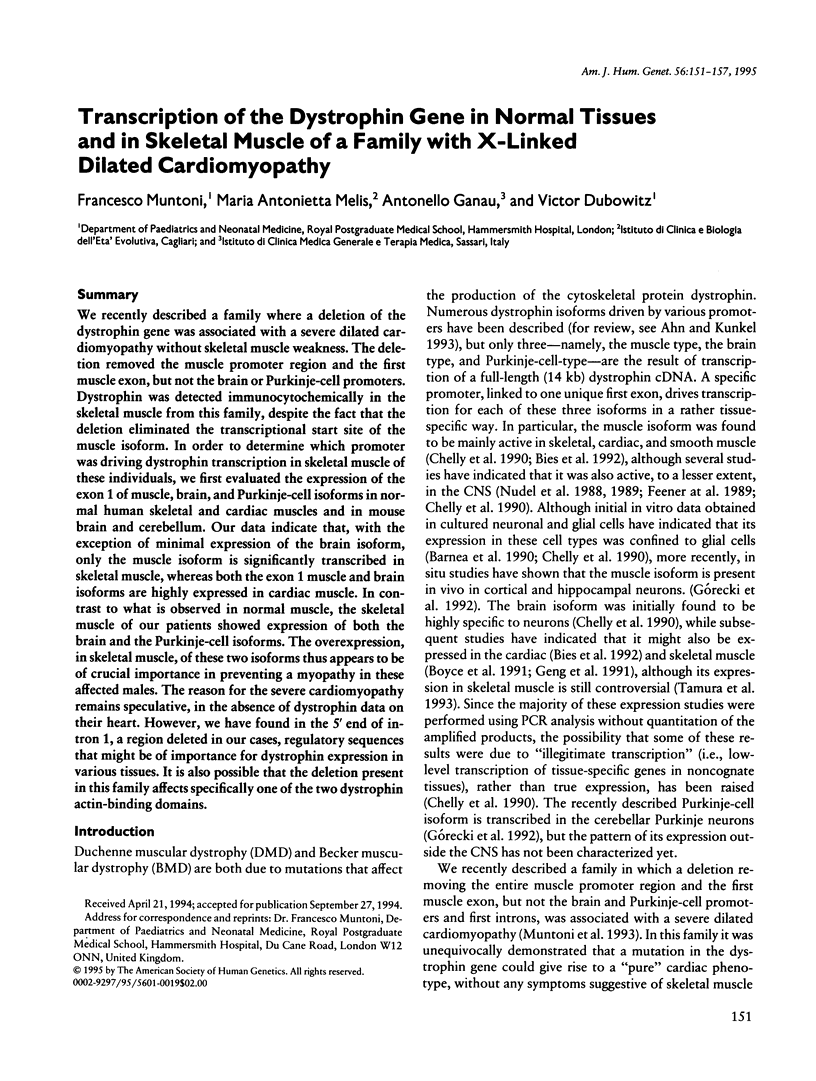
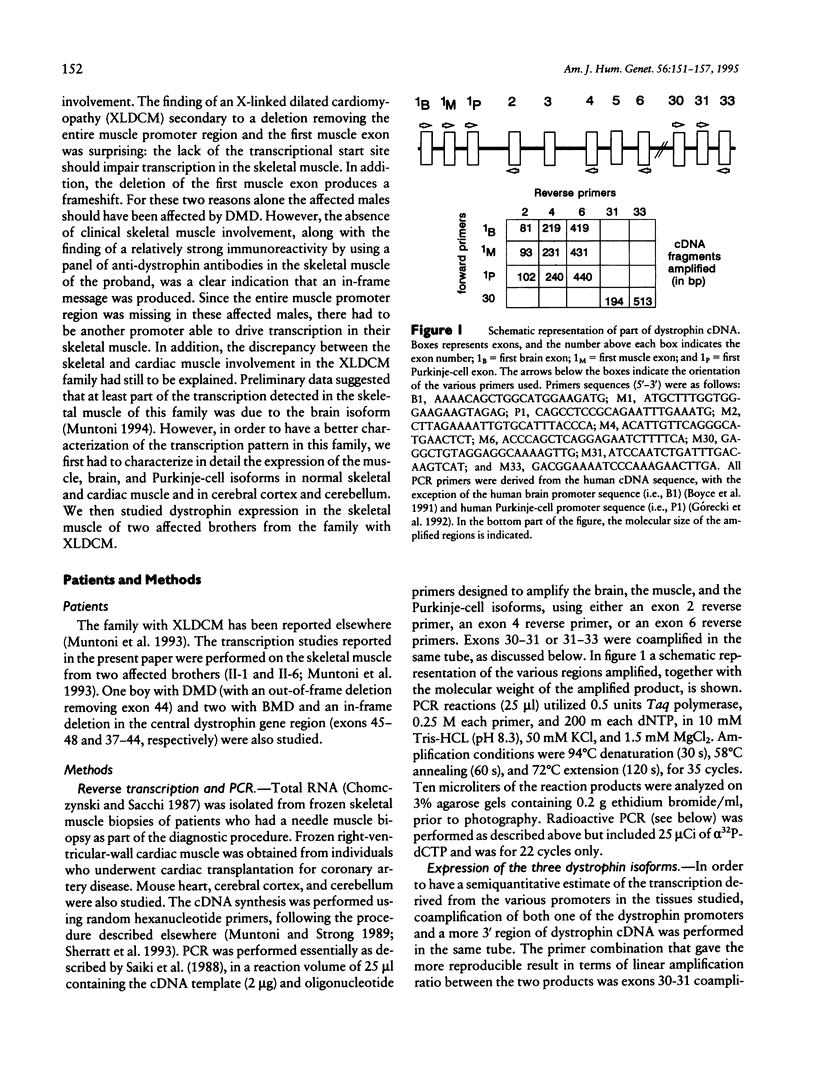
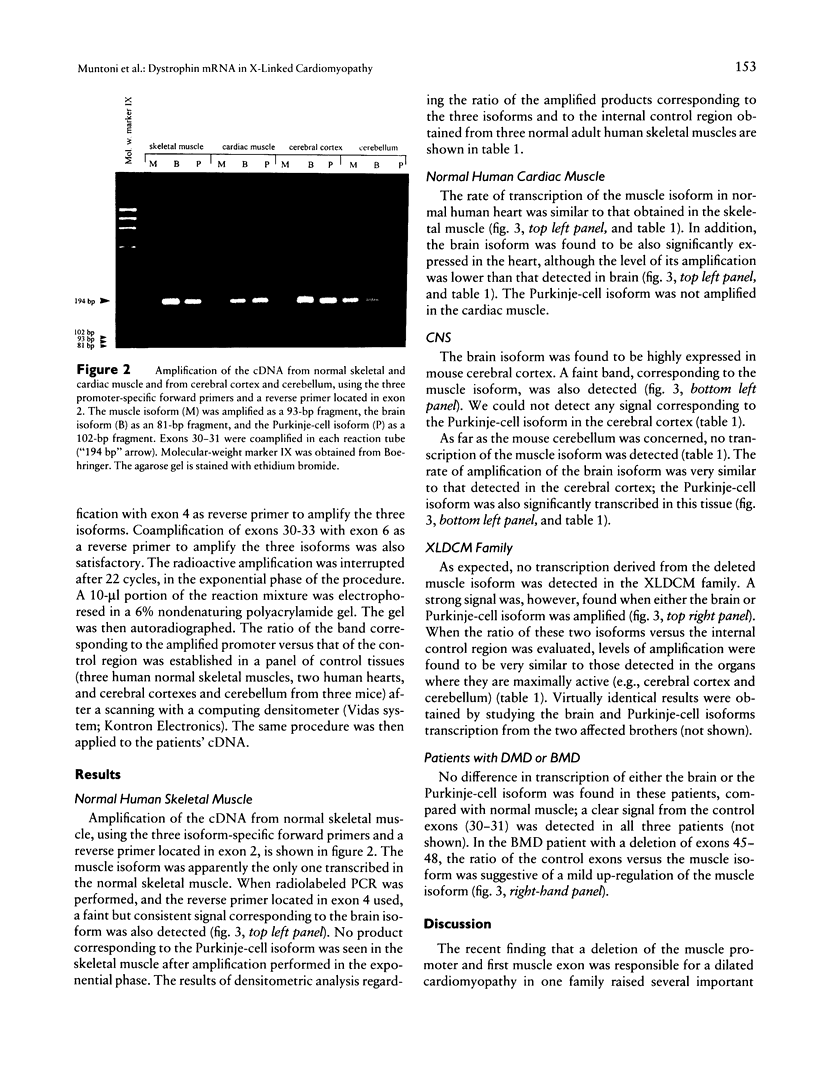
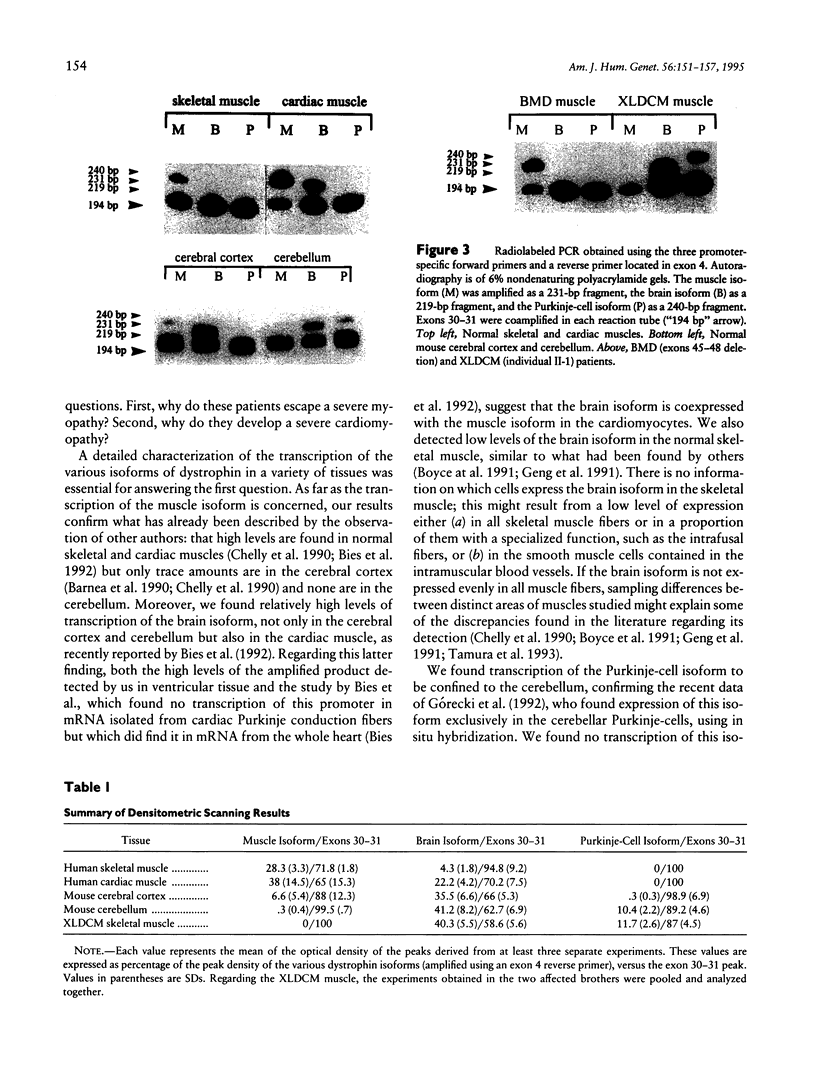

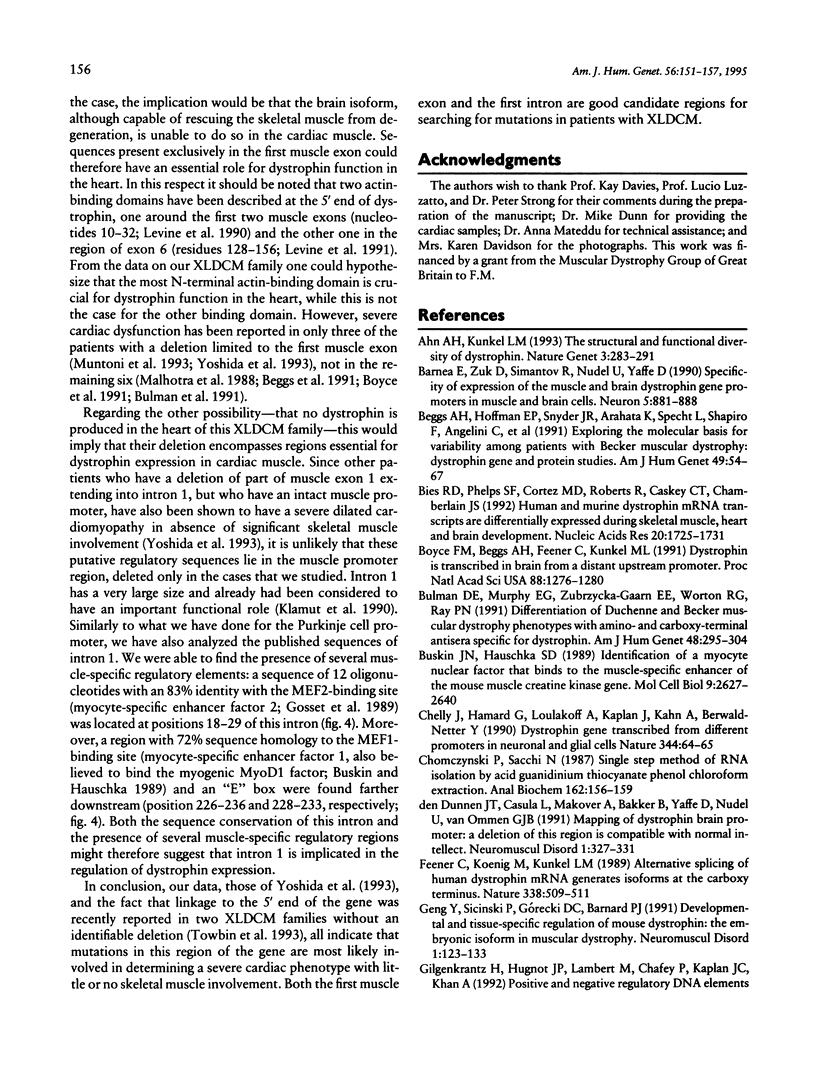
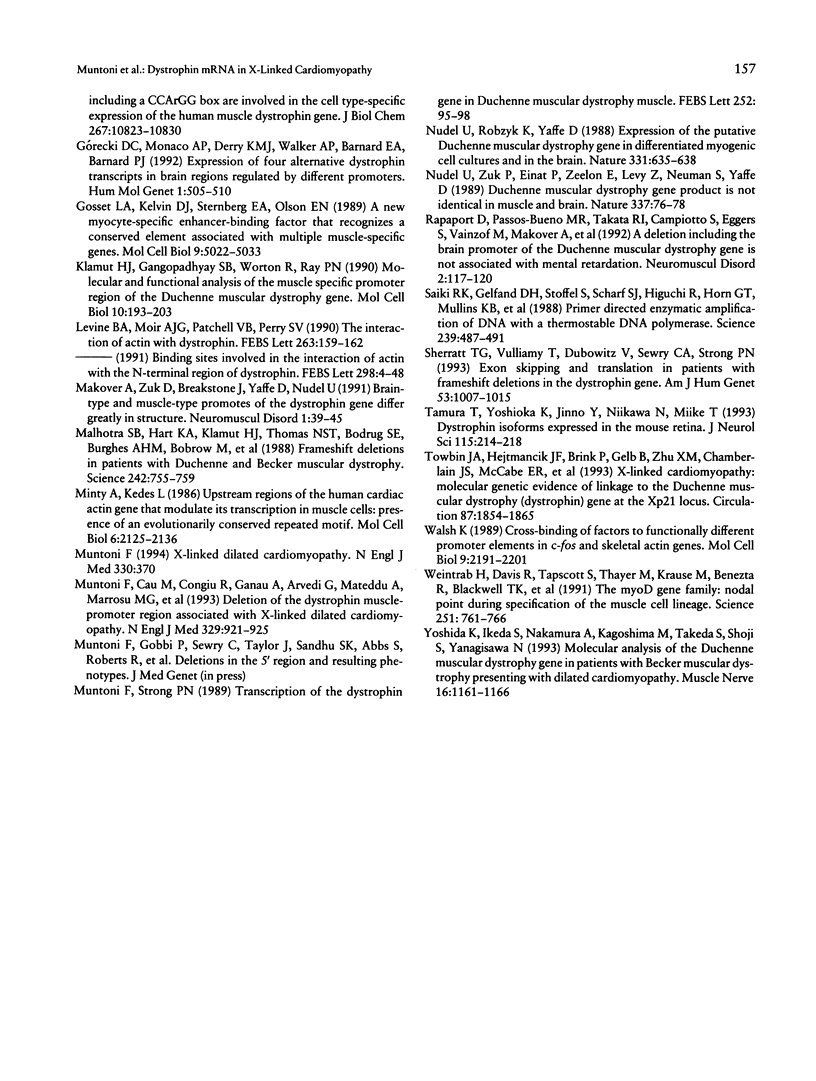
Images in this article
Selected References
These references are in PubMed. This may not be the complete list of references from this article.
- Ahn A. H., Kunkel L. M. The structural and functional diversity of dystrophin. Nat Genet. 1993 Apr;3(4):283–291. doi: 10.1038/ng0493-283. [DOI] [PubMed] [Google Scholar]
- Barnea E., Zuk D., Simantov R., Nudel U., Yaffe D. Specificity of expression of the muscle and brain dystrophin gene promoters in muscle and brain cells. Neuron. 1990 Dec;5(6):881–888. doi: 10.1016/0896-6273(90)90348-j. [DOI] [PubMed] [Google Scholar]
- Beggs A. H., Hoffman E. P., Snyder J. R., Arahata K., Specht L., Shapiro F., Angelini C., Sugita H., Kunkel L. M. Exploring the molecular basis for variability among patients with Becker muscular dystrophy: dystrophin gene and protein studies. Am J Hum Genet. 1991 Jul;49(1):54–67. [PMC free article] [PubMed] [Google Scholar]
- Bies R. D., Phelps S. F., Cortez M. D., Roberts R., Caskey C. T., Chamberlain J. S. Human and murine dystrophin mRNA transcripts are differentially expressed during skeletal muscle, heart, and brain development. Nucleic Acids Res. 1992 Apr 11;20(7):1725–1731. doi: 10.1093/nar/20.7.1725. [DOI] [PMC free article] [PubMed] [Google Scholar]
- Boyce F. M., Beggs A. H., Feener C., Kunkel L. M. Dystrophin is transcribed in brain from a distant upstream promoter. Proc Natl Acad Sci U S A. 1991 Feb 15;88(4):1276–1280. doi: 10.1073/pnas.88.4.1276. [DOI] [PMC free article] [PubMed] [Google Scholar]
- Bulman D. E., Murphy E. G., Zubrzycka-Gaarn E. E., Worton R. G., Ray P. N. Differentiation of Duchenne and Becker muscular dystrophy phenotypes with amino- and carboxy-terminal antisera specific for dystrophin. Am J Hum Genet. 1991 Feb;48(2):295–304. [PMC free article] [PubMed] [Google Scholar]
- Buskin J. N., Hauschka S. D. Identification of a myocyte nuclear factor that binds to the muscle-specific enhancer of the mouse muscle creatine kinase gene. Mol Cell Biol. 1989 Jun;9(6):2627–2640. doi: 10.1128/mcb.9.6.2627. [DOI] [PMC free article] [PubMed] [Google Scholar]
- Colford J. M., Jr, Newman T. B. Cat scratch disease. N Engl J Med. 1994 Feb 3;330(5):370–371. doi: 10.1056/NEJM199402033300517. [DOI] [PubMed] [Google Scholar]
- Feener C. A., Koenig M., Kunkel L. M. Alternative splicing of human dystrophin mRNA generates isoforms at the carboxy terminus. Nature. 1989 Apr 6;338(6215):509–511. doi: 10.1038/338509a0. [DOI] [PubMed] [Google Scholar]
- Geng Y., Sicinski P., Gorecki D., Barnard P. J. Developmental and tissue-specific regulation of mouse dystrophin: the embryonic isoform in muscular dystrophy. Neuromuscul Disord. 1991;1(2):125–133. doi: 10.1016/0960-8966(91)90060-6. [DOI] [PubMed] [Google Scholar]
- Gilgenkrantz H., Hugnot J. P., Lambert M., Chafey P., Kaplan J. C., Kahn A. Positive and negative regulatory DNA elements including a CCArGG box are involved in the cell type-specific expression of the human muscle dystrophin gene. J Biol Chem. 1992 May 25;267(15):10823–10830. [PubMed] [Google Scholar]
- Gossett L. A., Kelvin D. J., Sternberg E. A., Olson E. N. A new myocyte-specific enhancer-binding factor that recognizes a conserved element associated with multiple muscle-specific genes. Mol Cell Biol. 1989 Nov;9(11):5022–5033. doi: 10.1128/mcb.9.11.5022. [DOI] [PMC free article] [PubMed] [Google Scholar]
- Górecki D. C., Monaco A. P., Derry J. M., Walker A. P., Barnard E. A., Barnard P. J. Expression of four alternative dystrophin transcripts in brain regions regulated by different promoters. Hum Mol Genet. 1992 Oct;1(7):505–510. doi: 10.1093/hmg/1.7.505. [DOI] [PubMed] [Google Scholar]
- Klamut H. J., Gangopadhyay S. B., Worton R. G., Ray P. N. Molecular and functional analysis of the muscle-specific promoter region of the Duchenne muscular dystrophy gene. Mol Cell Biol. 1990 Jan;10(1):193–205. doi: 10.1128/mcb.10.1.193. [DOI] [PMC free article] [PubMed] [Google Scholar]
- Levine B. A., Moir A. J., Patchell V. B., Perry S. V. The interaction of actin with dystrophin. FEBS Lett. 1990 Apr 9;263(1):159–162. doi: 10.1016/0014-5793(90)80728-2. [DOI] [PubMed] [Google Scholar]
- Makover A., Zuk D., Breakstone J., Yaffe D., Nudel U. Brain-type and muscle-type promoters of the dystrophin gene differ greatly in structure. Neuromuscul Disord. 1991;1(1):39–45. doi: 10.1016/0960-8966(91)90041-p. [DOI] [PubMed] [Google Scholar]
- Malhotra S. B., Hart K. A., Klamut H. J., Thomas N. S., Bodrug S. E., Burghes A. H., Bobrow M., Harper P. S., Thompson M. W., Ray P. N. Frame-shift deletions in patients with Duchenne and Becker muscular dystrophy. Science. 1988 Nov 4;242(4879):755–759. doi: 10.1126/science.3055295. [DOI] [PubMed] [Google Scholar]
- Minty A., Kedes L. Upstream regions of the human cardiac actin gene that modulate its transcription in muscle cells: presence of an evolutionarily conserved repeated motif. Mol Cell Biol. 1986 Jun;6(6):2125–2136. doi: 10.1128/mcb.6.6.2125. [DOI] [PMC free article] [PubMed] [Google Scholar]
- Muntoni F., Cau M., Ganau A., Congiu R., Arvedi G., Mateddu A., Marrosu M. G., Cianchetti C., Realdi G., Cao A. Brief report: deletion of the dystrophin muscle-promoter region associated with X-linked dilated cardiomyopathy. N Engl J Med. 1993 Sep 23;329(13):921–925. doi: 10.1056/NEJM199309233291304. [DOI] [PubMed] [Google Scholar]
- Muntoni F., Strong P. N. Transcription of the dystrophin gene in Duchenne muscular dystrophy muscle. FEBS Lett. 1989 Jul 31;252(1-2):95–98. doi: 10.1016/0014-5793(89)80896-8. [DOI] [PubMed] [Google Scholar]
- Nudel U., Robzyk K., Yaffe D. Expression of the putative Duchenne muscular dystrophy gene in differentiated myogenic cell cultures and in the brain. Nature. 1988 Feb 18;331(6157):635–638. doi: 10.1038/331635a0. [DOI] [PubMed] [Google Scholar]
- Nudel U., Zuk D., Einat P., Zeelon E., Levy Z., Neuman S., Yaffe D. Duchenne muscular dystrophy gene product is not identical in muscle and brain. Nature. 1989 Jan 5;337(6202):76–78. doi: 10.1038/337076a0. [DOI] [PubMed] [Google Scholar]
- Rapaport D., Passos-Bueno M. R., Takata R. I., Campiotto S., Eggers S., Vainzof M., Makover A., Nudel U., Yaffe D., Zatz M. A deletion including the brain promoter of the Duchenne muscular dystrophy gene is not associated with mental retardation. Neuromuscul Disord. 1992;2(2):117–120. doi: 10.1016/0960-8966(92)90043-6. [DOI] [PubMed] [Google Scholar]
- Saiki R. K., Gelfand D. H., Stoffel S., Scharf S. J., Higuchi R., Horn G. T., Mullis K. B., Erlich H. A. Primer-directed enzymatic amplification of DNA with a thermostable DNA polymerase. Science. 1988 Jan 29;239(4839):487–491. doi: 10.1126/science.2448875. [DOI] [PubMed] [Google Scholar]
- Sherratt T. G., Vulliamy T., Dubowitz V., Sewry C. A., Strong P. N. Exon skipping and translation in patients with frameshift deletions in the dystrophin gene. Am J Hum Genet. 1993 Nov;53(5):1007–1015. [PMC free article] [PubMed] [Google Scholar]
- Tamura T., Yoshioka K., Jinno Y., Niikawa N., Miike T. Dystrophin isoforms expressed in the mouse retina. J Neurol Sci. 1993 Apr;115(2):214–218. doi: 10.1016/0022-510x(93)90227-p. [DOI] [PubMed] [Google Scholar]
- Towbin J. A., Hejtmancik J. F., Brink P., Gelb B., Zhu X. M., Chamberlain J. S., McCabe E. R., Swift M. X-linked dilated cardiomyopathy. Molecular genetic evidence of linkage to the Duchenne muscular dystrophy (dystrophin) gene at the Xp21 locus. Circulation. 1993 Jun;87(6):1854–1865. doi: 10.1161/01.cir.87.6.1854. [DOI] [PubMed] [Google Scholar]
- Walsh K. Cross-binding of factors to functionally different promoter elements in c-fos and skeletal actin genes. Mol Cell Biol. 1989 May;9(5):2191–2201. doi: 10.1128/mcb.9.5.2191. [DOI] [PMC free article] [PubMed] [Google Scholar]
- Weintraub H., Davis R., Tapscott S., Thayer M., Krause M., Benezra R., Blackwell T. K., Turner D., Rupp R., Hollenberg S. The myoD gene family: nodal point during specification of the muscle cell lineage. Science. 1991 Feb 15;251(4995):761–766. doi: 10.1126/science.1846704. [DOI] [PubMed] [Google Scholar]
- Yoshida K., Ikeda S., Nakamura A., Kagoshima M., Takeda S., Shoji S., Yanagisawa N. Molecular analysis of the Duchenne muscular dystrophy gene in patients with Becker muscular dystrophy presenting with dilated cardiomyopathy. Muscle Nerve. 1993 Nov;16(11):1161–1166. doi: 10.1002/mus.880161104. [DOI] [PubMed] [Google Scholar]
- den Dunnen J. T., Casula L., Makover A., Bakker B., Yaffe D., Nudel U., van Ommen G. J. Mapping of dystrophin brain promoter: a deletion of this region is compatible with normal intellect. Neuromuscul Disord. 1991;1(5):327–331. doi: 10.1016/0960-8966(91)90118-c. [DOI] [PubMed] [Google Scholar]




